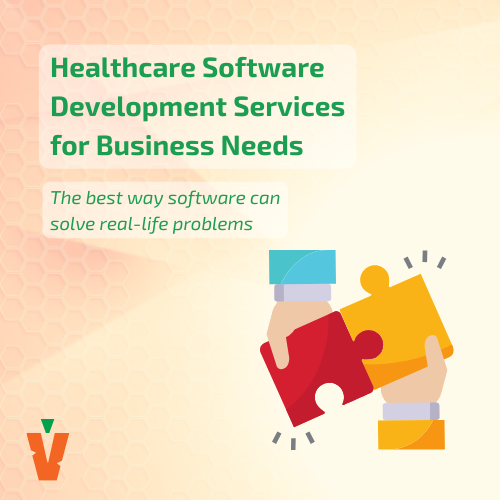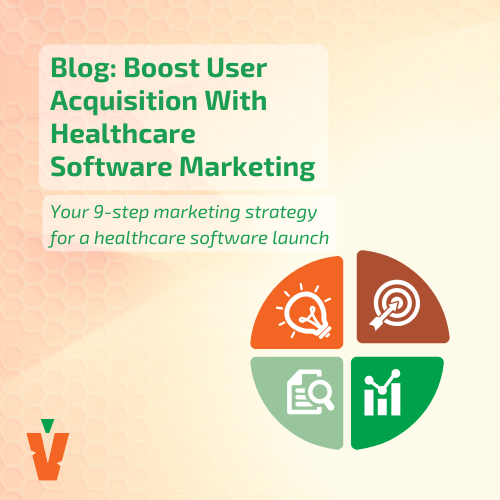The Best Way Software Can Solve Real-Life Problems
The average hospital produces 137 terabytes of data daily, but much is unstructured and hard to work with. Healthcare software development services could flip the script and boost the outcomes in these institutions — but only if you do it right.
Your task involves examining healthcare workflows, patients’ needs, government regulators, and business matters. But one thing’s clear — existing tech solutions aren’t doing a good job, and it’s on software developers to improve this situation.
How do you align your software with the needs of actual healthcare institutions? Join us to discuss the steps we use whenever we accept a new project at Vitamin. But first, let’s provide context to give you a better idea of your project goals.
Understanding Unique Healthcare Business Needs
While dealing with the day-to-day tasks of running a business, we often stop seeing the forest in favor of individual trees. The point of your company isn’t to meet its Q3 goal or reach a new demographic. Its aim is to satisfy a need or problem of your users. Everything else is just a product of stepping into the market with an idea.
As a decision-maker and person who enables projects to come to life, you as a PM must always keep their eyes on the business need. When it comes to healthcare, these needs rarely require you to introduce a new concept — rather, they boil down to solving the numerous challenges of this industry. While working with numerous healthcare institutions and software companies, we noticed the following as paramount for addressing the real-life needs of healthcare workers:
- In 2022, the average time between scheduling an appointment for a new patient and seeing a physician was 26 days. These waiting periods don’t only reduce satisfaction — they could endanger actual lives. Manual appointments slow everything down and reduce the number of providers who offer Medicaid, which harms millions.
- In 2021, 88% of physicians adopted EHRs; the number is even higher in 2024. From poor design to safety concerns, reports suggest that most existing systems don’t meet the needs of clinicians. Slow loading, information overload, and complex workflows make workers spend more time dealing with screens than patients, which harms patient outcomes.
- The CMS is prioritizing value-based care in 2024 and beyond. Due to this change, providers will be rated based on clinical outcomes, not just the service volume. While this is a change for the better, care institutions need numerous documents to demonstrate they’re offering value. The administrative burden is too much without good-quality technology systems.
- In 2023, 133 million health records leaked due to cybersecurity attacks. Poor tech infrastructure lets cyberattackers exploit vulnerabilities — better software could stop them and their costly consequences.
- Revenue leakage is ever-present in healthcare, with providers often undercompensated for their services. It primarily happens due to inefficient RCM (revenue cycle management) processes, where manual workflows are time-consuming and subject to human error. Resources say that 75% of providers still rely on manual processes, though.
That’s just the tip of the issue iceberg that could be improved through healthcare software development services.
How Quality Healthcare Software Can Help
Good healthcare software supports workflows, security, and patient outcomes. It can also improve data accessibility and security. Quality platforms and data warehouses reduce the risk of data breaches and unauthorized access while ensuring patient information is accurate and up-to-date, so there are no medical errors. All of this leads to better patient experiences, outcomes, and cost savings for the institution.
But here’s the trick. This only happens if your healthcare software actually aligns with the industry requirements. Your project goal must be to make lives easier for healthcare workers by aligning the capabilities of your technology with their real-world struggles.
This is the key difference between high-quality, well-implemented software and projects that miss the mark or never see the light of a release. Sadly, the latter is more common in healthcare — either because companies don’t know which KPIs to prioritize, suffer from non-tech-related issues that delay the launch, or fail to act upon feedback post-implementation. All of this results in a saturation of apps and platforms that look slicker than the ones used in the past decades, but add an equal number of issues to healthcare workers’ professional lives.
How do you avoid these pitfalls? Let’s discuss ways to keep project goals focused and technical objectives in line with them.
6 Steps to Aligning Technical and Business Objectives
From the Discovery Phase onward, your healthcare software development services must align with the provider’s business objectives and patient care goals. Conduct need assessments, map the workflow, and identify where tech can facilitate your client’s services. Here are the six steps to verify your project goals.

1. Create Detailed User Personas
When designing for healthcare, you must understand your future users. Interviewing doctors, nurses, and administrators goes a long way here, and it's one of the reasons why marketers should be a part of your early project plans.
Personas should encompass detailed profiles of future software users, highlighting their roles, challenges, and priorities. By understanding their needs and behaviors, healthcare Project Managers ensure the software features directly address real-life scenarios.
After determining demographics and psychographics, take a Jobs-to-Be-Done approach in this step. It defines what the user is ‘hiring’ your solution to do — keep notes, process payments, or update charts. Ask why they want a specific feature until you arrive at the base desire. From our experience, it’s less paperwork and time in front of the screen and more energy for patient care.
2. Establish Communication Channels
Standardize your communication channel — otherwise, critical details can get lost in the sauce. For instance, provide official updates via email or in meetings, while a Slack channel is great for quick questions.
Pro Tip: Send recaps after official meetings to show the client you’ve listened and allow them to correct misunderstandings.
And how often should you communicate? At Vitamin, we have our Project Managers do weekly check-in meetings. Your cadence will depend on the project size, complexity, and the client’s involvement.
3. Validate Gathered Requirements
During the Discovery Phase, analyze the client’s business needs and determine the baseline requirements for your healthcare software. The client should validate them before you craft the final SRS document.
Even after you have the specifications, things might shift when you start developing. That’s why it’s a best practice to create and verify a prototype before designing an MVP. It green-lights the design and engages the stakeholders — it’s a win-win.
4. Manage Client Expectations
As a Project Manager in healthcare, you ensure that future technology will support healthcare providers. But it’s also your responsibility to explain that a single app can’t do everything.
Managing client expectations includes clear project goals, timelines, and deliverables. You should also communicate risks or restraints and (if possible) devise a mitigation strategy together. Clarity also eliminates the risk of scope creep that delays and destabilizes the project.
Pro Tip: If you do a demo and the client demands a change, perform triage before you jump to fixing. Determine if they caught a bug or seek a new functionality. The latter is grounds for redoing the SRS to meet the new project goal or request.
At Vitamin, we operate on the base of SoW agreements. This lets us produce a well-rounded app or module within a single timeframe, sticking to the most viable and capital-efficient method.
5. Get Buy-In for Key Decisions
Perception is essential in healthcare software adoption. If your clients can’t see the value you’re bringing, they’re unlikely to embrace the new technology. That’s why you need buy-in before you finalize the features.
By demonstrating the rationale behind decisions and highlighting their alignment with business objectives, Project Managers build commitment in their stakeholders. As a result, you’ll find it easier to implement updates and deploy the software.
In healthcare software, you also want to get buy-in from future end users. Doctors and nurses think differently than engineers, and they might see a flaw in what seems to be the ideal system. Put their needs first and take their suggestions seriously.
6. Gather and Act Upon Feedback
Project Managers should solicit feedback from end-users and subject matter experts at every project milestone. For healthcare software development services, this includes drafting the SRS, finalizing the features, and performing UAT.
For instance, you can look at the statistics and see that 72% of physicians want better user interfaces in EHRs, and 67% want better interoperability. But how does that look in practice? From our experience, you always get better results from asking than assuming, so have the typical end-users on the demo and let them try the MVP hands-on.
This feedback allows your engineers to create new, better iterations of the healthcare software. Each new version will be more helpful and aligned with the business needs.
Key Takeaways & Next Steps
Aligning technological and healthcare needs is necessary if you want your software to support the industry. Understand and integrate the daily operations of healthcare providers to make health tech more intuitive, efficient, and valuable. Once developers prioritize this as their project goals, better patient outcomes will naturally follow.
Are you struggling to match your healthcare software development service with your client’s needs? As consultants, we bridge the gap between technology and business issues in healthcare. Schedule a consultation to have our Business Analyst check your plan and offer feedback. The Sanity Check is a helpful methodology for early project stages, too.




